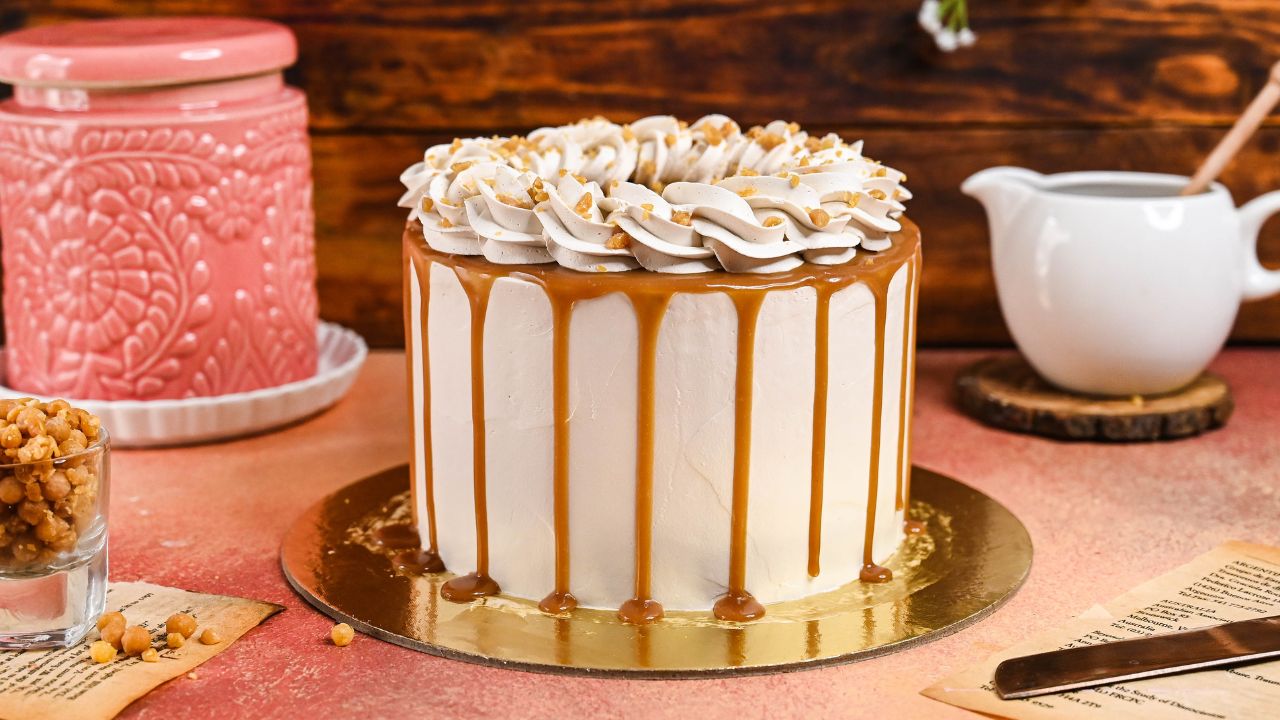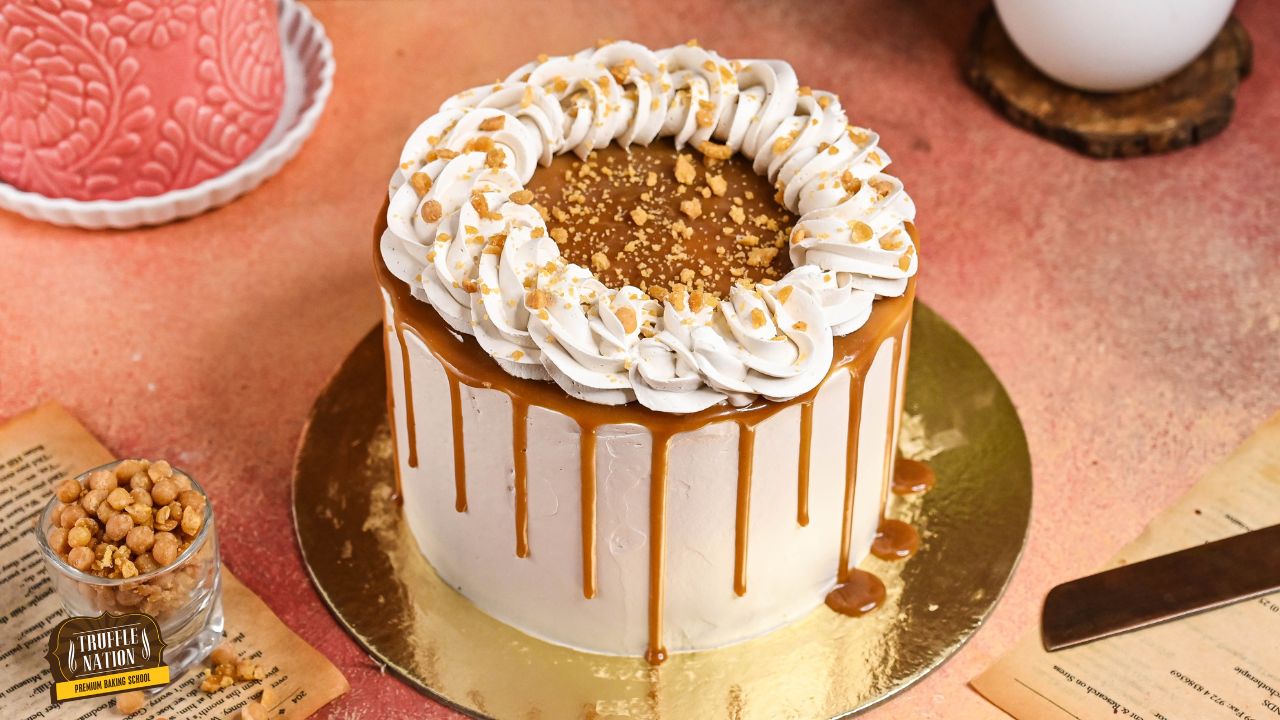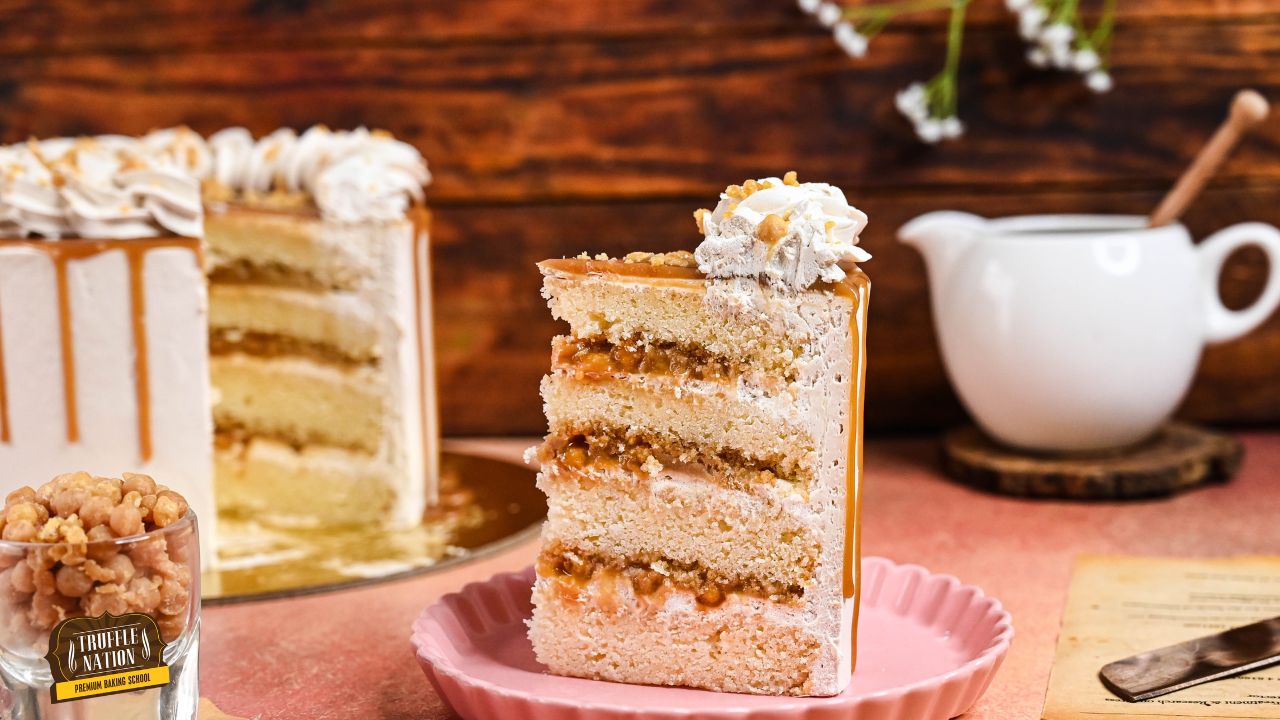I present you with the ultimate eggless butterscotch cake. I remember the first time I tried the butterscotch cake; let me tell you, it was pure bliss. And from that moment, it has stuck to my taste buds. I often used to go to the same bakery shop to have that exact cake over and over again. And today, I tried to bring the same taste with this butterscotch cake made from scratch. With its luscious butterscotch sauce and velvety sponge, I am sure it will also capture your heart, just like it captured mine.

If you are one of those people who doesn’t know what a Butterscotch Cake is and what it tastes like. Let me answer it in one word, and that is ‘HEAVEN’. This butterscotch cake has a tender and moist sponge, homemade butterscotch sauce, and butterscotch frosting topped with butterscotch nuts and drip. It’s the perfect cake for gifting to your loved ones or for any given occasion. And I am sure everyone in your family will give you many positive compliments for this cake.
Why You Will Love This Recipe?
There are many reasons to love this recipe for Butterscotch Cake, and I have listed some of them below:
- Butterscotch: This homemade butterscotch sauce is the ultimate reason to love this recipe. It is easy and simple to make. It has been added to the frosting, used as a drip and has been added in between layers for lots of flavours.
- Flavour: This recipe imparts the ultimate flavour of Butterscotch Cake. Rich and decadent, this cake offers a unique butterscotch flavour through the homemade butterscotch sauce. The combination of sweet and slightly salty flavours creates a distinct taste, making it a delightful treat for people with sweet tooth and non-sweet lovers.
- Texture: this cake has all the elements of a perfect cake. Smooth and creamy frosting with light and tender sponge layers, resulting in a cake that is so satisfying to bite into.
- Homemade goodness: while you can find a butterscotch cake in any bakery shop, there is something exceptional about making it at home. The process of making it at home is a reward in itself. And the end result is both satisfying and delicious. And homemade cakes are always far healthier than store-bought ones as you select the ingredients that are fresh and high in quality.
- Crowd Pleaser: butterscotch cake is generally loved by all, making it perfect for any occasion. This cake’s familiar and comforting taste can make your loved ones ask for more.

Important Ingredients Used In The Recipe:
- Brown sugar: it is one of the key ingredients used in making homemade butterscotch sauce. The molasses present in it provide the distinct flavour of butterscotch and colour to the sauce.
- Butter: in this recipe, butter has been used in the sponge and butterscotch sauce. It creates a rich, tender and soft crumb of the sponge. It also adds richness and sheen to the butterscotch sauce.
- Corn flour: to make the sponge soft and tender, I added a little corn flour to the batter.
- Buttermilk: I have substituted egg with buttermilk since it is an egg-free cake. It works wonders, providing a soft, moist, fluffy texture to the sponge.
- Salt: salt is added to enhance the butterscotch sauce’s distinct flavour.
- Vanilla Essence: this ingredient has been used in almost all of the elements of this cake. Even for making soaking syrup, I have used vanilla essence. Vanilla essence gives the cake a lovely aroma.
How To Make The Butterscotch Cake?
For complete instructions and the quantity of the ingredients, see the recipe box.
Preparation: collect and weigh all the ingredients correctly before starting. Preheat the oven to 180°C or 350° (OTG mode: lower rod + upper rod + fan), grease two 6-inch round baking tin with oil, and line it with butter paper at the bottom.
For homemade butterscotch sauce:
Place Ingredients in Saucepan: in a heavy-bottom saucepan, add all the ingredients that are brown sugar, butter, fresh cream, salt and vanilla essence.
Cook: let it simmer and bring it to a boil while stirring occasionally until it thickens.
Cool: transfer it to a bowl and let it cool down before using it in the element.
For sponge
Buttermilk: make instant buttermilk by mixing apple cider vanilla with the milk and keep it aside to curdle. You can also use store-bought plain buttermilk if you have one. Apple cider vinegar gives the buttermilk more flavour than synthetic white vinegar.
Mix Butter And Sugar: add melted butter and icing or powdered sugar in a bowl and cream them using an electric hand beater until fully incorporated and the mixture is pale and fluffy. It should take around 3-4 minutes.
Add Dry Ingredients: sift the dry ingredients in the same bowl and mix with a spatula. You will see a crumb-like texture.
Add Buttermilk: Gradually add buttermilk in parts and mix properly to make a smooth, lump-free batter.
Bake: Transfer the batter into the baking tins equally and bake them at 180°C or 350° (OTG mode: lower rod) for 30-35 minutes or until a toothpick inserted in the middle comes out clean with a few crumbs sticking.
For Frosting
Whip Cream and Butterscotch Sauce: make sure both butterscotch sauce and whipping cream are cold before mixing. Add whipping cream and butterscotch sauce in a big bowl, then start whipping with an electric hand beater until a soft peak is achieved. Transfer it to piping bags and set aside.
Assembly
De-mould the Sponge: before starting the assembly, de-mould the cake and divide the sponges into two parts using a cake leveller. Using a cake leveller will help you in getting even layers of sponges.
Assemble First Layer: Place a cake base on a turn table and spread a little bit of frosting so that our cake doesn’t budge from the place while layering and frosting.
Soak and Frost: now place a sponge layer and soak with soaking syrup using a pastry brush. Pipe some frosting through a pipe and smooth it with a palette knife. On top of the frosting, spread some of the butterscotch sauce and sprinkle butterscotch nuts.
Assemble Rest Of The Layers: place another layer of sponge and repeat the same with the rest of the layers.
Crumb-coat: For crumb-coating the cake, pipe a thin layer of frosting and smooth it out using the same palette knife. Remove the excess with a scrapper. Crumb coating helps the stray crumbs to stay in place, resulting in a smooth final coat. So, make sure you do not skip on crumb coating the cake.
Freeze: after crumb coating, keep in the fridge for about 15-20 minutes so that the frosting sets a little and helps in the final coating.
Final Coating: After 15 minutes, give the crumb-coated cake its final coating by piping thick layers of frosting all over it and smoothing it out.
Decorate: now, on top, spread the butterscotch sauce and give a drip effect by piping it through a piping bag. Pipe spirals on the top edge of the cake using a 1M nozzle. Sprinkle crushed butterscotch nuts on top as well.

Chef’s Tip For The Recipe
Tip For Creaming
Cream melted butter and icing sugar properly. Beat them until a light and fluffy texture is achieved. This process results in a tender cake.
Add Buttermilk In Batches
While adding buttermilk, make sure you add it in parts. This will help you in mixing the ingredients easily.
Tip for Butterscotch Sauce
While making butterscotch sauce, make sure not to stir vigorously, or the brown sugar will crystallize.
While making the frosting, ensure the butterscotch sauce is cold and not warm; otherwise, the whipping cream won’t whip correctly.
How To Store Butterscotch Cake?
To store the frosted cake, keep it in an airtight container inside the fridge, or the frosting will dry out. It can be stored in a refrigerator for up to 3 days.
It can be stored at room temperature for 1 day as it is a fully frosted cake.
You can freeze the frosted cake as well. Make sure that you keep it in an airtight container.
The baked sponge can be stored in the fridge for up to 2 weeks, while in the freezer, it can be stored for up to 1 month.
The butterscotch sauce can be stored in the fridge for up to 1 month. While for frosting, it can be stored in the refrigerator for one week.
Frequently Asked Questions
The key ingredient that gives the butterscotch cake its distinct flavour is a butterscotch sauce made with brown sugar. Its caramel-like flavour provides a rich, buttery and slightly nutty flavour to the cake.
Using castor sugar will alter the flavour of butterscotch sauce, making it a regular caramel.
Although butterscotch buttercream is preferred in making a butterscotch cake, I have used whipping cream to frost it to make it light. You can also use caramel or simple vanilla frosting to frost the cake.
Yes, you can freeze the butterscotch cake. Ensure you keep it in an air-tight container so the frosting doesn’t get dried out.
It may be due to over mixing of the batter. Or you have added too much sugar or oil. Ensure you add the exact quantity in the recipe and do not over-mix the batter.
